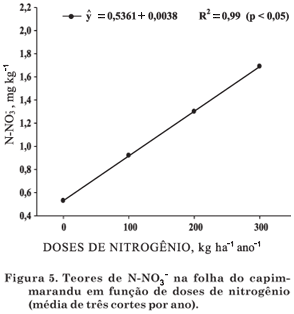Nitrogen fertilization positively influences nutritional aspects in grass and can result in largely recovered pastures. The research objective was to study the nutrition of marandu grass treated with nitrogen doses and sources, by methods of indirect determination of chlorophyll (SPAD) and total nitrogen concentration and the relation between them and inorganic nitrogen contents (N-NH4+ and N-NO3-) in plant leaves. The experiment was carried out from July of 2003 to March of 2006 on a model farm of the Universidade Estadual de Goiás, in an area of 882 m². The pasture had been used for more than ten years and the herbage yield was low and considered moderately degraded. A split-plot with three replications was used. The experiment had a complete randomized block, 2 x 4 factorial design, with two nitrogen sources (ammonium sulfate and urea) and four nitrogen doses (0, 100, 200, and 300 kg ha-1 yr-1 ). In each year, marandu grass was cut and evaluated three times. Chlorophyll contents increased owing to the nitrogen doses and over the years. Nitrogen concentration was highest after the application of highest nitrogen doses in form of ammonium sulfate. The chlorophyll content and leaf nitrogen concentration in newly expanded leaves of marandu grass were directly related. Mineral nitrogen concentration (N-NH4+ and N-NO3-) represented little total nitrogen fraction of forage lives. Chlorophyll meter can be used for evaluation of nutritional state of marandu grass to know nitrogen absorption. The inorganic nitrogen concentration (N-NH4+ and N-NO3-) represented a small fraction of total nitrogen in the forage leaves.
Brachiaria brizantha; chlorophyll meter; nutritional state; nitrogen; SPAD






